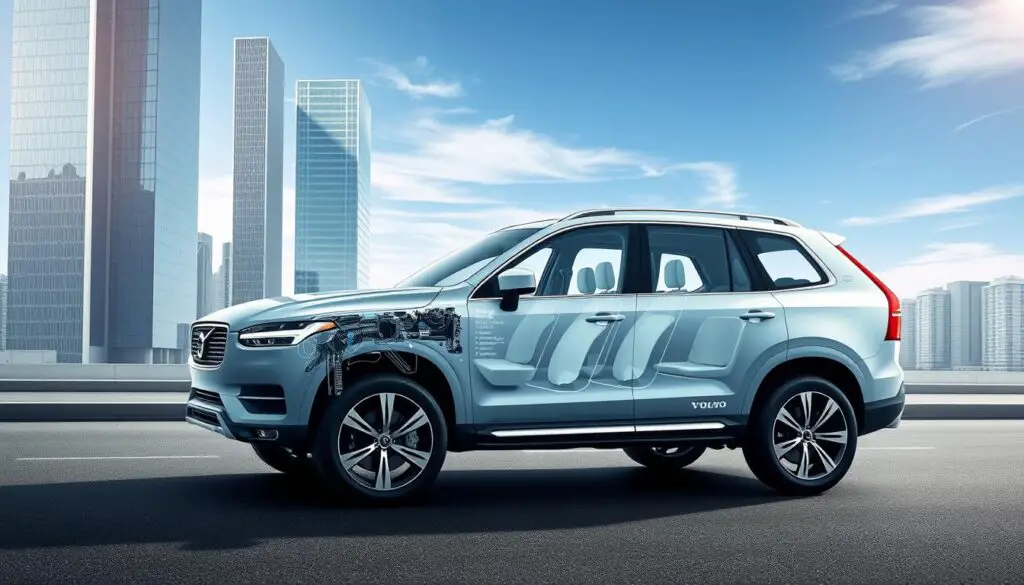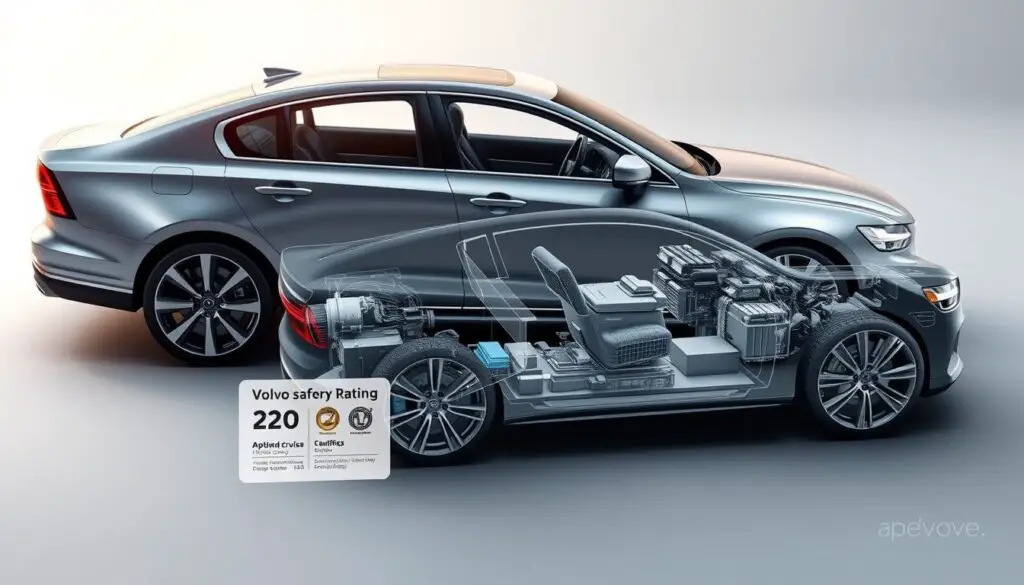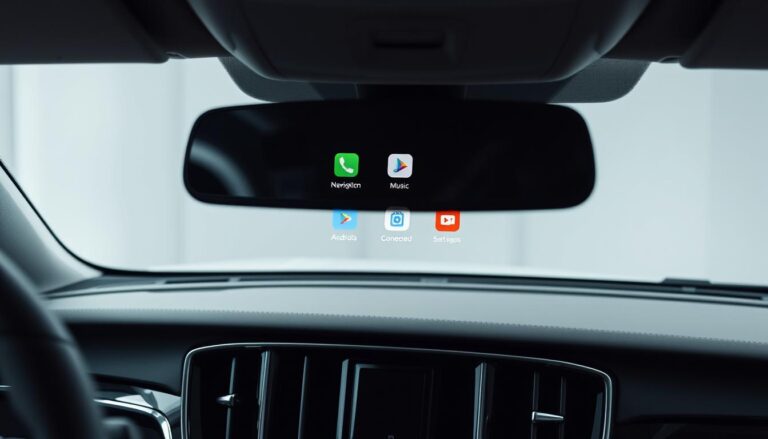Volvo has long been synonymous with safety, pushing the boundaries of automotive innovation to protect drivers and passengers alike. With a commitment to reducing accidents and enhancing vehicle safety features, Volvo continues to set industry standards.
The Swedish automaker’s dedication to protecting lives on the road is evident in its comprehensive approach to vehicle design and technology. From advanced airbag systems to sophisticated collision avoidance systems, Volvo’s safety ratings are a testament to its relentless pursuit of excellence.
Key Takeaways
- Volvo’s historical perspective on safety innovations
- Advanced safety features in recent Volvo models
- The significance of Volvo’s safety ratings in the automotive industry
- Technologies that contribute to Volvo’s high safety ratings
- Volvo’s commitment to reducing accidents and enhancing vehicle safety
Overview of Volvo Safety Ratings
Understanding Volvo’s safety ratings is crucial for appreciating the brand’s commitment to protecting its occupants. Volvo has long been synonymous with safety, and its vehicles are consistently among the highest rated in safety assessments.
Why Safety Ratings Matter
Safety ratings are a critical measure of a vehicle’s ability to protect its occupants in the event of a crash. They are determined by rigorous testing protocols that assess various aspects of vehicle safety, including crashworthiness, crash avoidance, and the effectiveness of safety features. Volvo’s commitment to achieving high safety ratings is evident in its incorporation of advanced safety technologies, such as automatic emergency braking and lane departure warning systems.
The importance of safety ratings cannot be overstated. They provide consumers with valuable information about the safety performance of vehicles, helping them make informed purchasing decisions. Moreover, safety ratings drive manufacturers to improve their safety standards, fostering a culture of continuous innovation in vehicle safety.
Key Organizations Involved in Safety Testing
Several key organizations are involved in testing and rating the safety of vehicles. The National Highway Traffic Safety Administration (NHTSA) and the Insurance Institute for Highway Safety (IIHS) are two of the most prominent bodies in the United States. The NHTSA conducts rigorous crash tests and evaluates vehicles based on their performance, assigning safety ratings from 1 to 5 stars. The IIHS, on the other hand, conducts a range of tests, including small overlap front, moderate overlap front, side impact, roof strength, and head restraints & seats evaluations.
- The NHTSA’s 5-star rating system provides a comprehensive assessment of a vehicle’s safety performance.
- The IIHS’s Top Safety Pick+ designation is awarded to vehicles that excel in all safety tests and have superior crash prevention features.
- Volvo’s vehicles frequently receive top ratings from both organizations, underscoring the brand’s commitment to safety.
By understanding the safety ratings and the organizations that determine them, consumers can gain a deeper appreciation for Volvo’s dedication to safety and its efforts to protect drivers and passengers.
Volvo’s Commitment to Safety
With a legacy of pioneering safety innovations, Volvo has consistently raised the bar in the automotive industry. This commitment is evident in its historical safety achievements and its ambitious future goals.
Historical Perspective on Volvo’s Safety Innovations
Volvo’s history is marked by numerous groundbreaking safety features that have become standard in the industry. One of its most significant contributions was the introduction of the three-point seatbelt in 1959, a innovation that has saved countless lives. This invention not only showcased Volvo’s dedication to safety but also set a new standard for the automotive industry.
Over the years, Volvo has continued to innovate, introducing advanced safety technologies such as whiplash protection systems and advanced driver assistance systems (ADAS). These advancements have not only enhanced the safety of Volvo’s vehicles but have also influenced the broader automotive industry, pushing competitors to follow suit.
Volvo’s Vision2020: No Fatalities or Serious Injuries
In line with its commitment to safety, Volvo introduced Vision2020, an ambitious initiative aimed at achieving a future where no one is killed or seriously injured in a new Volvo. This vision represents a significant step forward in Volvo’s ongoing quest to make its vehicles as safe as possible.
To achieve this goal, Volvo has been working on developing and implementing a range of safety technologies, including advanced driver assistance systems and autonomous driving capabilities. For more insights on how Volvo compares to its competitors in terms of safety, you can read our analysis on Volvo vs Audi.
By setting such an ambitious target, Volvo is not only driving change within its own organization but is also encouraging the entire automotive industry to strive for higher safety standards. This proactive approach to safety underscores Volvo’s position as a leader in the field.
Recent Volvo Models and Their Safety Ratings
The 2023 Volvo XC90 and S60 are the latest examples of Volvo’s dedication to safety, featuring advanced safety technologies and impressive crash test results. Both models embody Volvo’s long-standing commitment to protecting drivers and passengers.
2023 Volvo XC90 Safety Ratings
The 2023 Volvo XC90 has received top safety ratings from various reputable testing organizations. Its advanced safety features, including City Safety (a collision avoidance system) and Run-Off Road Protection, contribute to its exceptional safety performance.
For more detailed information on the safety features and ratings of other Volvo models, you can visit this page to learn about the 2025 Volvo XC60.
| Safety Feature | Description | Rating |
|---|---|---|
| City Safety | Collision avoidance system | 5/5 |
| Run-Off Road Protection | Protection in case of running off the road | 5/5 |
| Whiplash Protection System (WHIPS) | Reduces risk of whiplash injuries | 5/5 |
2023 Volvo S60 Safety Ratings
The 2023 Volvo S60 also boasts an impressive safety record, thanks to its comprehensive suite of safety features. These include automatic emergency braking and lane departure warning, among others.

The S60’s safety ratings are a testament to Volvo’s commitment to safety across its model lineup. With its advanced safety technologies, the S60 provides drivers with peace of mind on the road.
Safety Features in Volvo Vehicles
Volvo’s commitment to safety is evident in the array of advanced safety features integrated into their vehicles. These features are designed to enhance the safety of drivers, passengers, and pedestrians alike.
Advanced Driver Assistance Systems (ADAS)
Advanced Driver Assistance Systems (ADAS) are a crucial component of Volvo’s safety technology. These systems utilize a combination of sensors, cameras, and radar to detect potential hazards and assist the driver in avoiding accidents. Some of the key ADAS features in Volvo vehicles include:
- Collision Avoidance Systems
- Lane Departure Warning and Correction
- Adaptive Cruise Control
- Blind Spot Monitoring
Volvo’s ADAS technology is designed to be intuitive and unobtrusive, providing drivers with critical safety information without being distracting. This technology has been shown to significantly reduce the risk of accidents.

Crash Test Performance and Results
Volvo’s focus on safety is also reflected in its exceptional crash test performance. The company’s vehicles have consistently achieved high ratings in rigorous testing conducted by reputable organizations.
| Model | NHTSA Rating | Euro NCAP Rating |
|---|---|---|
| 2023 Volvo XC90 | 5-Star | 5-Star |
| 2023 Volvo S60 | 5-Star | 5-Star |
The table above illustrates the outstanding safety performance of two recent Volvo models. These ratings are a testament to Volvo’s dedication to volvo safety features and overall vehicle safety.
Comparison with Competitors
The safety landscape of the automotive industry is significantly influenced by Volvo’s commitment to safety, but how does it stack up against other brands? To understand Volvo’s standing, it’s essential to compare its safety ratings with those of its competitors.
How Volvo Stacks Up Against Other Brands
Volvo is often regarded as a leader in automotive safety, but other manufacturers are also making significant strides. Brands like Audi, BMW, and Mercedes-Benz are continually enhancing their safety features, making the competition fierce.
When comparing safety ratings, it’s crucial to look at the data from reputable sources such as the National Highway Traffic Safety Administration (NHTSA) and the Insurance Institute for Highway Safety (IIHS). According to the IIHS, Volvo models like the XC90 have received Top Safety Pick+ ratings, a feat matched by few other manufacturers.
Safety Ratings of Notable Competitors
Let’s examine the safety ratings of some of Volvo’s notable competitors:
- Audi Q7: Received a Top Safety Pick+ rating from the IIHS, with advanced safety features like adaptive cruise control.
- BMW X5: Also achieved a Top Safety Pick+ rating, boasting features such as automatic emergency braking.
- Mercedes-Benz GLE: Earned a Top Safety Pick rating, with enhancements like lane-keeping assist.
While these competitors offer impressive safety features, Volvo’s consistent commitment to safety and its Vision2020 initiative set it apart. As noted by
“Safety is a key differentiator for Volvo, and our goal is to ensure that no one is seriously injured or killed in a new Volvo by 2020.”
This commitment underscores Volvo’s leadership in the safety domain.
In conclusion, while competitors are closing the gap, Volvo’s legacy and ongoing innovations in safety continue to make it a benchmark in the industry.
Future Safety Innovations from Volvo
As the automotive industry continues to evolve, Volvo remains committed to pushing the boundaries of safety. With a strong foundation in safety innovations, Volvo is poised to introduce new technologies that will further enhance vehicle safety.
Advancements in Safety Technology
Volvo’s commitment to safety is reflected in its ongoing development of advanced safety features. The company’s vision for a safer automotive future includes the integration of cutting-edge technologies that will help prevent accidents and minimize injuries.
Sustainable Safety Approach
By prioritizing volvo safety standards, the company is working towards a future where vehicles are not only safer but also more environmentally friendly. Volvo’s approach to sustainable safety involves the development of electrified vehicles and the sharing of safety data to promote industry-wide improvements.
FAQ
What safety ratings has Volvo achieved in recent models?
Volvo has consistently achieved high safety ratings in its recent models, with many earning top ratings from organizations such as the National Highway Traffic Safety Administration (NHTSA) and the Insurance Institute for Highway Safety (IIHS).
What are some of the advanced safety features found in Volvo vehicles?
Volvo vehicles are equipped with a range of advanced safety features, including Advanced Driver Assistance Systems (ADAS) such as lane departure warning, adaptive cruise control, and automatic emergency braking.
How does Volvo’s safety record compare to its competitors?
Volvo is generally considered one of the safest car brands on the market, with many of its models outperforming competitors in safety ratings and crash tests. The company’s commitment to safety is reflected in its rigorous testing protocols and incorporation of advanced safety features.
What is Volvo’s Vision2020 initiative, and what are its goals?
Volvo’s Vision2020 is an initiative aimed at achieving zero fatalities or serious injuries in its vehicles by 2020. While the target year has passed, Volvo continues to work towards this ambitious goal, pushing the boundaries of automotive safety and striving to make its vehicles as safe as possible.
How do Volvo’s safety ratings vary across different models?
Volvo’s safety ratings can vary slightly across different models, but the company has a strong overall safety record. Models such as the 2023 Volvo XC90 and S60 have achieved high safety ratings, with many featuring advanced safety technologies and achieving top ratings in crash tests.
What role do organizations like the NHTSA and IIHS play in evaluating Volvo’s safety ratings?
Organizations like the NHTSA and IIHS play a crucial role in evaluating Volvo’s safety ratings, conducting rigorous testing and evaluation to assess the safety performance of Volvo vehicles. Their ratings provide consumers with an independent assessment of a vehicle’s safety features and crashworthiness.
Are Volvo’s safety innovations limited to its own vehicles, or are they shared with other manufacturers?
Volvo has a history of sharing its safety innovations with other manufacturers, having made several of its safety patents available to the industry. This has helped to drive safety improvements across the automotive industry as a whole.
What upcoming safety technologies is Volvo developing?
Volvo is continually developing and refining its safety technologies, with a focus on advanced driver assistance systems, autonomous driving, and other innovations. The company is committed to pushing the boundaries of automotive safety and making its vehicles as safe as possible.



